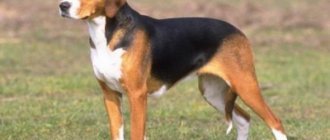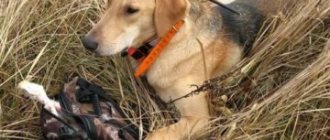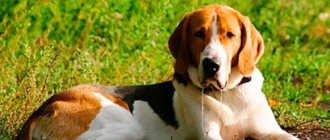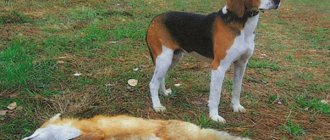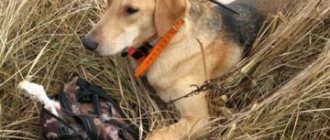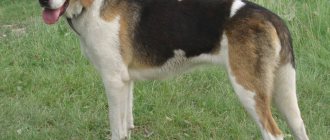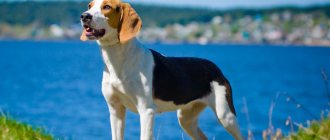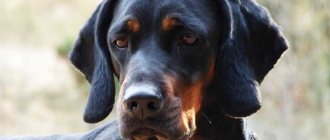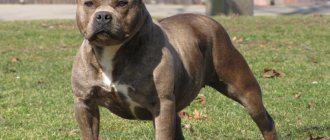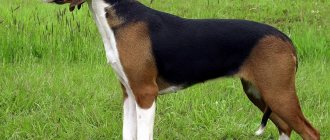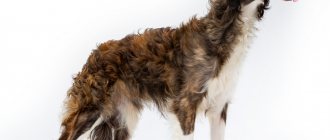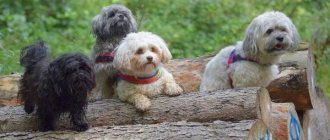Dog hunting, which was previously only the domain of the upper classes, has become much more accessible these days. And the choice of hunting dogs (from wolfhounds to greyhounds) will pleasantly please you not only with their excellent exterior (the appearance of the dogs), but also with decent working qualities. Of all the variety of breeds, it is worth noting such as the Russian Piebald Hound (also known as the Anglo-Russian Hound).
Brief history of the breed
Hunting with hounds was originally the domain of aristocrats, and the work of hounds was considered auxiliary and only the quality of the pack’s work was assessed. It was at this time (or more precisely, in 1810) that the first mentions of Russian piebald hounds appeared. The breed was developed completely by accident, by infusing Russian hounds with the blood of foxhounds, which were extremely popular at that time. It is thanks to Foxhounds that this breed is also called Anglo-Russian. It was only by 1925 that the Russian piebald was officially recognized and began to be bred.
Distinctive features
A distinctive feature of the breed is its animal-like appearance. Russian hounds are somewhat reminiscent of wolves: head posture, jaw, gaze. In general, these are well-built large dogs of an elongated format. At the withers they can reach 68 cm. At the same time, the dogs look fit and graceful.
The breed is not recognized by the International Canine Organization, so the standard is the same - Russian. It was adopted in 1925 and rewritten in the 60s of the 20th century. At the moment, nurseries take care of the purity of the breed line in order to achieve international recognition.
- The head is small, dry, wedge-shaped. The skull is flat. The back of the head and brow ridges are not pronounced. Stop outlined.
- The muzzle is slightly longer than the head, narrow but well filled. The jaws are strong with a full set of teeth. Scissor bite The lips are thin and dense.
- The nose is wide, black, with open nostrils.
- The eyes are slanted, almond-shaped, set slightly above the stop. The color of the iris is dark.
- The ears are thin, short, fit tightly to the head, and droop. Set above the eye line.
- The body is strong and harmonious. The topline is straight. The back is long and wide, the loin is convex, the croup is sloping. The withers are pronounced. The chest is wide and deep. The neck is long. The belly is tucked in.
- The tail is not long (above the hock), thick at the base, tapered towards the end. In an active state it rises above the line of the back, in a calm state it is lowered.
- The limbs are straight, parallel, dry with pronounced joints and articulations. Paws are collected, oval. Movement : gallop or trot.
- The coat is hard, short, and characterized by lengthening on the body, limbs, neck and tail. The undercoat is thick and soft.
- Colors: wheaten, crimson, tan, gray, tricolor.
How can an Anglo-Russian hound help a hunter?
Rather, the question should be posed this way: is it necessary to use dogs for hunting? After all, keeping them is troublesome: you have to feed them, walk them, teach them, and in the 21st century, you can easily use some kind of gadget instead of dogs. For example, a night vision device or a thermal imager.
Dog lovers will answer unequivocally: it is necessary! And there are several reasons for this:
- The dogs will find the game. Of course, relying on hunting experience and technological progress, you can search for game on your own, especially large ones, but when it comes to birds or hares, even modern technologies can’t always help. But the dogs will find the game, and (in the case of hounds) drive the hunter out.
- The dogs give time to prepare for the shot. If the hare actually breaks away from under your feet, then you are unlikely to have time to aim or shoot. The hound will help “lift” him and bring him straight to you. All that remains is to prepare properly and wait.
- The dogs will bring game. Especially useful when hunting in deep snow or other conditions that make movement difficult. In addition, the chance of loss will be significantly reduced.
- A faithful dog is man's best friend. And no gadget can replace this.
- Hunting with a hound will bring much more drive and pleasure from the process than a simple trip with a gun.
However, hunting with a dog also has its disadvantages:
- An inexperienced hunter, who does not know the animal and its habits well, would rather spoil the dog than train it.
- Some animals are better hunted without using hounds.
- Training requires patience and a certain amount of tolerance.
- Some dogs may have birth defects that make training or rutting difficult.
What is the best Russian piebald hound to hunt?
The hound is considered a universal dog, capable of hunting any forest inhabitants, but hounds perform best in hunting hare, fox, wolf, raccoon dog and wild boar.
However, remember that if the hounds are accustomed to hunting wild boar (which usually takes place in open areas), then they will get used to a simple and completely unpretentious rut. If they have to hunt more cautious and cunning animals (for example, foxes or hares), then serious difficulties will arise.
Advantages and disadvantages
Owners of the Russian-English hound note both the positive and negative aspects of the breed. The advantages include:
- Passion for hunting, which is an innate trait.
- Strong and sonorous voice.
- Increased degree of viscosity and good crawling (the dog is able to pursue prey for a long time and find the trail well).
- Tirelessness and endurance.
Note! The positive aspects also include a very good thick coat, which allows the dog to calmly endure winters in the enclosure.
Many consider the heightened hunting instinct to be a disadvantage. Because of it, a dog is even able to leave its owner, carried away by hunting and prey.
Description of the main characteristics of the hound:
- viscosity (perseverance in pursuit);
- fidelity (barks only at the hunted game);
- crawling (ability to find game);
- Paratus (fast rut);
- restlessness (tirelessness during prolonged pursuit);
- good voice (strong, clear, musical and ringing bark);
- skill (work skill);
- good instinct;
- gregariousness (the ability to drive an animal in a pack or in a band, without separating from each other);
- quarrelsomeness (quick gathering of a bow or flock);
- evenness of legs (cohesion of the flock);
- urge (obedience to a challenge);
- politeness (obedience to the hunter, as well as indifference to livestock).
Russian piebald hounds: features and character
- Calm and balanced character.
- The Russian Piebald Hound can withstand enormous physical exertion, but do not overuse it, otherwise the dog may lose interest in the rut or simply become spoiled.
- Excellent sense of smell. It is difficult even for experienced foxes to throw off the scent of a well-trained hound.
- She has a strong voice, so when hunting she will easily give a signal to her owner.
- Doesn't bark or show aggression without a reason.
- The breed is short-haired, which means there will be fewer problems with cleaning the premises during shedding.
Russian pinto hound puppies
If you are planning to get a puppy, then when choosing one you should pay attention to:
- Papers. Study the pedigree, it is recommended - up to 4 generations. “C” students can give weak offspring, given the increased number of frauds at exhibitions, give preference to “excellent” students. Be sure to find out whether the puppies had cattlemen in their family (those who attacked domestic animals) and silent ones (they drove the animal silently, without barking). If there is at least one such ancestor, you should not take a puppy.
- Mother. Must be thin, but not emaciated, contented, and not exhibit any behavioral abnormalities.
- Appearance of a puppy. Well-fed, cheerful, active, agile and, naturally, clean.
- Room. Dry and quite spacious.
Regime and diet
It is not recommended to feed a pet of this breed once a day; in this case, it will often feel hungry. The dog is given food 2 to 4 times a day. It is imperative to take into account the needs of a particular dog - some need a hearty breakfast, others will not go to bed without a good, nutritious dinner.
It is preferable to feed the dog natural food - fresh meat, vegetables, rich cereals. A treat for your pet is a sugar beef bone. But small, hollow seeds should be discarded. To maintain excellent health and hunting qualities when hunting “naturally,” you will need vitamins.
Prohibited foods include fatty pork, smoked meats, confectionery, baked goods, seasonings, spices, and marinades. Dry ready-made rations can also be included in the diet, but they are given infrequently and always separately from the usual dishes. As a rule, high-quality feed is used.
Care
The Russian piebald is extremely unpretentious; it can be brushed quite rarely (once every few days), and bathed as needed. Given their calm nature, such dogs get along well with children, but they are very active, and they require either frequent active walks (when the owner plays with the dog or lets it off a leash) or a large living space (the yard of a private house or cottage).
You should not show weakness or indulge the dog’s whims, otherwise the piebald hound will later become completely disobedient.
Also, you should not deceive her by calling her to you or in any other cases. If the dog distrusts you, then it will take a long time to learn and be reluctant to follow commands.
The last rule is not to “humanize” the dog. Do not let her sleep on the bed, eat from the table, do not try to comfort an upset animal of any breed with affection, etc.
Character
The Russian hound has a rather calm character. It accumulates energy from hunting to hunting, so it is not particularly active at home. However, it is impossible to get a companion from such dogs; they like to show independence in everything. It is almost impossible to force a dog to do something it doesn’t want to do.
He perceives small domestic animals as prey (including cats), and will try to catch them to the last. However, these dogs have practically no territorial instinct and suspicion; you should not hope to make him a guard. Such pets do not experience negativity towards strangers, they can only simply bark at him.
Training
Russian Pinto Hound puppies train best when they are three months old. From this time until 3.5 months or a year, depending on the approach to training (Training is the development of the hound’s innate skills and consolidation of the developed ones), it is necessary to teach the puppy the commands “Come to me!” "Stand!" and others included in the OKD (general training course), as well as accustom to the sound of a horn and a shot.
To train a hound to listen to a horn, you need to blow it before feeding, and blow it on the same horn, the sound of which the piebald hound will remember forever, and when hunting, it will never confuse the sound of the horns. You should not blow the horn all day long, otherwise the dog will lose all interest in it and become uncontrollable in the forest. This, in turn, can not only ruin the pleasure of hunting, but also lead to the death or loss of the dog.
The next step is to teach the dog the command “Open!” (to make the dog throw the food). After training, you will be able to safely take prey while hunting. Before feeding, the animal is tied to a long leash (from 5 to 8 meters), threaded through a ring fixed in the wall, and the end of the leash remains in the hands of the owner. Throw some treat and give the command “Discover!” If the hound bares its teeth and growls, then pull the dog to the ring with one hand, and take the bone with the other. Russian pinto hound puppies usually understand the command 2-3 times, however, if the puppy persists, as an exception, you can lightly punish him. After completing the command correctly, praise the dog and give it a treat (but not the one you took away, of course).
From a very early age, it is necessary for your Russian Piebald to become accustomed to being polite (a term described in “Basic Characteristics”) and not attacking livestock and/or your other pets. If a dog manages to kill any domestic animal at least once and is not punished, then this vice will remain with it for the rest of its life.
Therefore (especially if the dog is vicious, or you live in the city), try to bring the dog near livestock and birds and patiently teach it complete indifference by pulling back or punishing it.
Socialization
From the age of three months you can start raising a puppy. It is very important to instill qualities such as courage. Communication with peers is a fundamental point: sitting alone, the puppy will never learn to defend himself.
A basic training course will help you get used to other people. Special training programs, specifically for hunting dogs, will lay the foundations of hunting skills: not to be afraid of barking, loud sounds of a shot and a hunting horn, to be able to correctly grab game.
If there is a small child in the family, you need to carefully monitor how he communicates with his four-legged friend. A puppy, sensing a threat from a small person, may bark and even bite in self-defense. A puppy that grows up with a child will be more loyal to him.
Catch-up
A puppy of any breed can be introduced to the forest at the age of 4 months, but walks should last about an hour and not turn into a challenge, otherwise there is a high risk of overworking the puppy and causing him to become disgusted with the process.
By 8-9 months, subject to the above-mentioned requirements, training can begin. Many authoritative experts recommend starting training at one year old, arguing that any breed of hound reaches the necessary physical development at this time. Naturally, you can start training earlier, but if you value your pet, it is better to wait a while rather than spoil the animal.
For the first training, it is recommended to take the dog alone, without an experienced “partner”. Despite the fact that this way the dog will learn faster and better, it can become exhausted trying to keep the rhythm of an experienced dog, and also adopt his possible vices.
The duration of the process depends on weather conditions and the physical condition of the dog. This usually takes about 3-4 hours with a break of 20-30 minutes after an hour or two of training.
It is best to carry out the race in the fall, in September or October, or in the spring, in April or May, in specially designated places. The Anglo-Russian hound, which was hunted in winter (along a white trail), is considered to be less well trained, since it is widely believed that in this case it looks for the trail “by eye” and will not cope with the spring-autumn hunt. The hunt is usually carried out on hares, and then - depending on who you plan to hunt and how.
How does the process work? The hunter walks through the area, and so that the speed of the dog’s movement matches his own, poking (by shouting, urging the dog to action) from time to time. The squealing should be approximately the same, since the dog remembers the characteristic squealing of the owner in the same way as the sound of the horn. The dogs, not hearing the owner, begin to search for him and either get lost or search with a minimum crawling depth (game search zone).
If the Russian piebald goes too far, then, on the contrary, it is necessary to scurry less often.
If a dog is afraid of the forest and stays near its feet, then under no circumstances should you scold it for this, much less punish it. Otherwise, the fear of the forest will take root firmly in her mind, and she will have to forget about a good hunting dog.
But, sooner or later (this is the nature of the breed) you will find a hare and raise it.
Faults that disqualify the breed
Any deviation from the standard is assessed depending on the degree of its severity, therefore not all developmental defects are related to marriage. Among breeders, there are concepts such as faults, defects and vices that disqualify a breed.
The disadvantages of the RPG breed include:
- height deviations up to 2 cm;
- slight short or long legs;
- underdevelopment of muscles;
- the presence of folds on the head or neck;
- timidity;
- pronounced nape;
- overly convex brow ridges;
- smoothed transition from forehead to muzzle;
- slight hump nose;
- a pronounced furrow in the middle of the forehead;
- strongly defined cheekbones;
- broad forehead;
- large or small ears;
- low-set ears;
- slightly rolled ears;
- light eyes and eyelids;
- small or slanted, or low-set eyes of a round shape;
- small, sparse teeth;
- minor manifestation of caries;
- pincer bite in individuals over six years of age;
- absence of up to 4 teeth;
- poorly developed muscles and fur in the neck area;
- low or high set neck;
- poorly developed undercoat;
- too long or short hair;
- slightly barrel-shaped chest;
- slightly elongated lower back;
- too tucked stomach;
- significant speckling;
- too light or bright blush (tan) in the coat color;
- sluggish movements;
- tail too long or short;
- weak hair on the tail;
- flat or elongated paws;
- hock joints turned slightly inward or outward.
Vices:
- Deviations in height of more than 2 cm;
- obvious short legs;
- strong folds on the neck and head;
- poorly developed muscles and bones;
- short upturned head;
- hump nose;
- sharp transition from forehead to muzzle;
- brown or light colored nose;
- light small eyes;
- ears that are too large or small, covered with thick hair;
- low-set, curled ears;
- absence of at least one incisor;
- absence of four or more premolars from among P2, P3 and lower P4;
- absence of at least one upper P4;
- neck with poorly developed muscles;
- very low set neck;
- drooping or hunched back;
- long weak loin;
- underdeveloped barrel-shaped sternum;
- clubfoot;
- straight shoulders;
- elbows turned too far out;
- asymmetrical bite;
- the presence of intense markings or blush extending below the carpal or hock joints;
- shortened step, weak push;
- curvature of the tail;
- lack of undercoat;
- wavy long hair.
Faults that disqualify the breed:
- different eye colors, green or blue eyes;
- absence of canine or molars M1, M2;
- incomplete closure of the jaws;
- lack of blush (tan);
- mouse color.
Skol
Soon the prey will be out of sight. In this case, the hounds continue to search for her, but following the scent. Usually a young piebald hound loses track after the first hare discount and becomes silent (the so-called hiatus). It is at this time that the hunter must intervene.
IMPORTANT! The hare's mark is a little behind where the hound lost the trail.
The hunter must either find and scare away the hare, or help the dog do this. It is necessary for her to understand that she needs to continue searching for the trail. It happens that dogs cannot take it again. Then the hunter must walk a circle with the dog, and then another larger one, in order to detect the trail. The more persistent you are in searching for a trace during the first surges, the more persistently the dog will search for traces subsequently. And vice versa, the dogs of lazy hunters, who switch after a discount to another trail of a hare, will behave in exactly the same way during the hunt, so such owners may not even count on prey and a good rut.
And a couple more tips:
- Don't leave your hound alone in the woods, hoping it will return home on its own. This instills in dogs a passion for wandering and negatively affects their character.
- During the race, do not be distracted by anything. Do not shoot squirrels or birds, do not collect mushrooms, etc. The Russian Piebald will pick up your habit and will subsequently be often distracted during its work.
Brief summary
- The Russian piebald hound is ideally suited for hunting hares and foxes.
- The calm and balanced nature of the breed will make training easier.
- Hunters without experience are not recommended to train hounds.
- It is necessary to approach the choice of puppies with due responsibility, checking not only the papers, but also the puppies themselves, as well as the conditions of their detention.
- The first training of this breed is carried out either in spring or autumn.
- For training, you should not pair up an experienced dog.
- Don't skip the silence and help the dog get back on the trail.
Health and characteristic diseases
The Russian piebald hound has good health, endurance and excellent immunity. With proper maintenance and a balanced diet, no problems with the health of the animal should arise.
However, you need to know what diseases this breed still has:
- hip dysplasia is a congenital joint problem in some puppies;
- myositis - muscle inflammation, accompanied by swelling and lameness;
- conjunctivitis is an inflammation of the eyes, which without the help of a veterinarian can become chronic.
